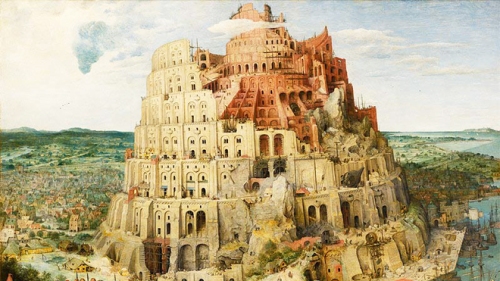- Tower of Babel
The Tower of Babel (Genesis 11:1-8,9)

“Therefore its name was called Babel, because there the Lord confused the language of all the earth. And from there the Lord dispersed them over the face of all the earth.”
This passage, which is among the shortest and most obscure in the entire Bible to cover something so intense, would seem to indicate that language was the source, not of racial differences, but merely of the dispersal of humans to various parts of the globe.
I am going to approach these passages as having historical significance as well as biblical and theological significance. I know that there are many, including serious Bible-believing Christians who think these are best understood as parables, not historical. However, I am approaching them with their impact on racial thinking.
Of course, why would this have been across racial lines (by the Shem, Ham, Japheth theory)? Did God strike all the Shemites with all the same, or at least similar languages, and so they ended up lumping in together? None of the Hamites got those languages?
Again, as is always (or at least often) the case with deep and ancient passages of the Hebrew Scriptures, we scratch our head looking for good interpretation. It seems like these accounts explain two different things (racial development & division and language development & division) in two very different accounts that perhaps somehow overlap. Without a time machine, it is just not possible to interpret these with precision…
Now, certainly, this spreading out effect would work well with the idea of how genetic differences developed over time – evolution of the genetic structures over hundreds of generations of people isolated from one another would presumably begin to have phenotype differences as well.
As Noah’s descendants migrated from the Middle East after the Tower of Babel, their group numbers would have grown smaller as they extended further out. As the groups grew smaller, certain genes within the human gene pool became dominant, while others became recessive or even just latent.
The idea is that with time and generations, these genes produced the skin color, bone structure and other physical characteristics that made each group distinctive within its isolated geographical area.
Of course, what we know now is more complex than just “people who went North became white while people who went South became darker”… though there is a certain logic to nearness to the equator and sun requiring darker skin to survive, as we learn more about how early human migrated, intermarried, etc., we will continue to learn about the complexities.
That all being said, the theological concept buried here is that God was the impetus for man spreading out and forming into nations and eventually, what we call ethnic groups. Whether you take any of these as historical in nature, the vision for the ethnic diversity of the race of mankind rests with God.
In the simplest terms, all of the previous 9 chapters are summarized in Genesis 10:5
“By these were the isles of the Gentiles divided in their lands; every one after his tongue, after their families, in their nations”.
The first chapters of Genesis are meant to tell us the Who and the Why of the creation and early development of the race of humans as moral creatures who develop cultivation, pottery, and language under His guiding hands.
Overall, the Old and New Testaments show that God does not assign any special significance to race.
God sees all people as one people called “man.” Physical characteristics are not a part of God’s evaluation of man “. . .for man looketh on the outward appearance, but the Lord looketh on the heart” (I Samuel l6:7).
God states clearly He is not a respecter of persons, and that includes race or nationality – though Israel had a special covenant from God, that was not because of anything special about them. In the end, He revealed to Peter the truth about God’s opinion of nationalities:
“So Peter opened his mouth and said: “Truly I understand that God shows no partiality, 35 but in every nation anyone who fears him and does what is right is acceptable to him.” (Acts 10:34-35)
Race, as defined by Webster’s Dictionary, is not really or clearly even a Biblical concept and nowhere can it be shown that physical characteristics of people are a reason or a guide to distinguish one from  another that I can find.
another that I can find.
God is not a respecter of race, nor sex, nor socio-economic status:
27 For as many of you as were baptized into Christ have put on Christ. 28 There is neither Jew nor Greek, there is neither slave nor free, there is no male and female, for you are all one in Christ Jesus. (Galatians 3:27-28)
This is God’s view of humanity in regards to the diversity of humanity. In Christ, we are one.
One common application of bad theology of race has to do with intermarriage. (**** link coming)
Pingback: My Theology of Race – Part 2 | Chris Legg, LPC